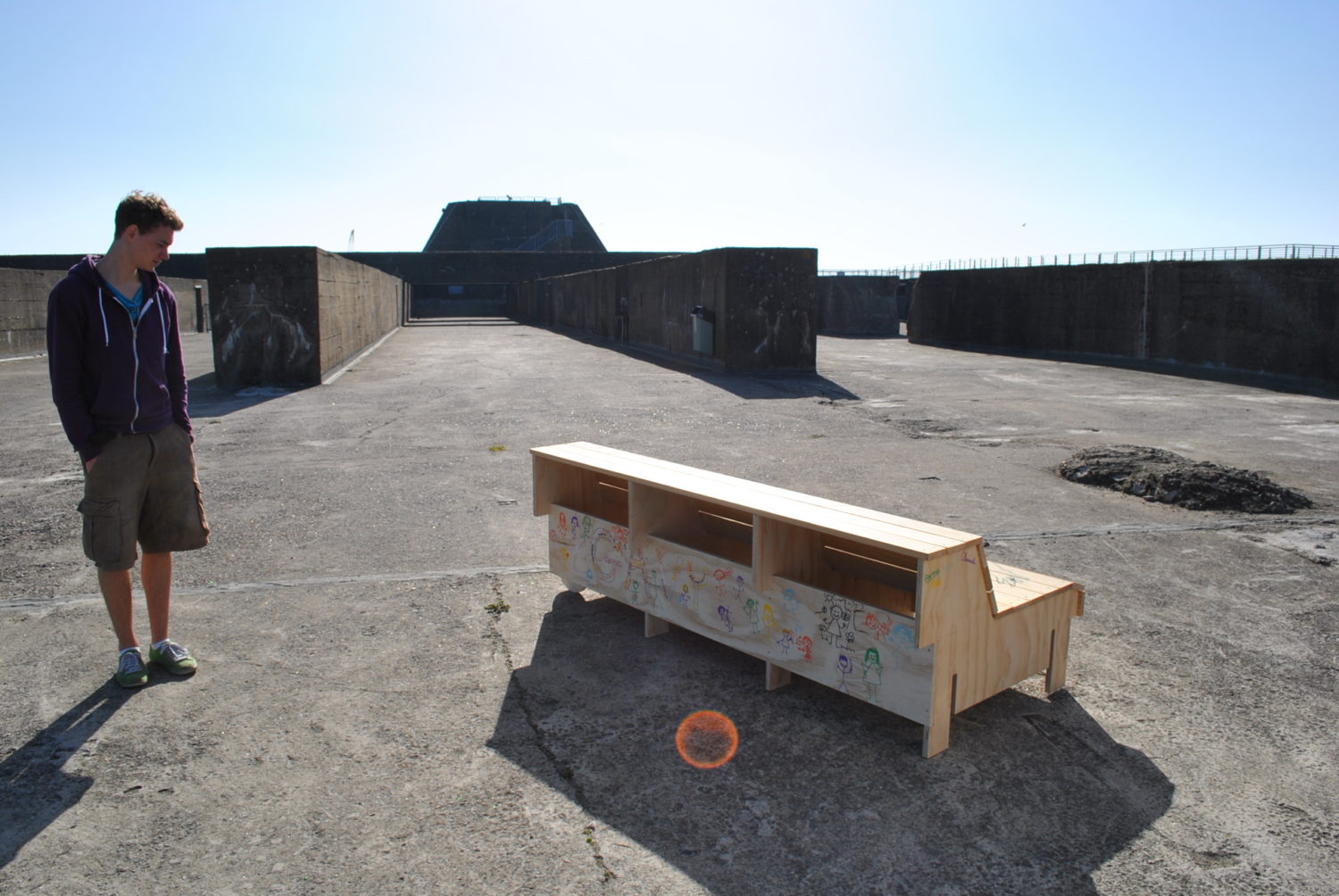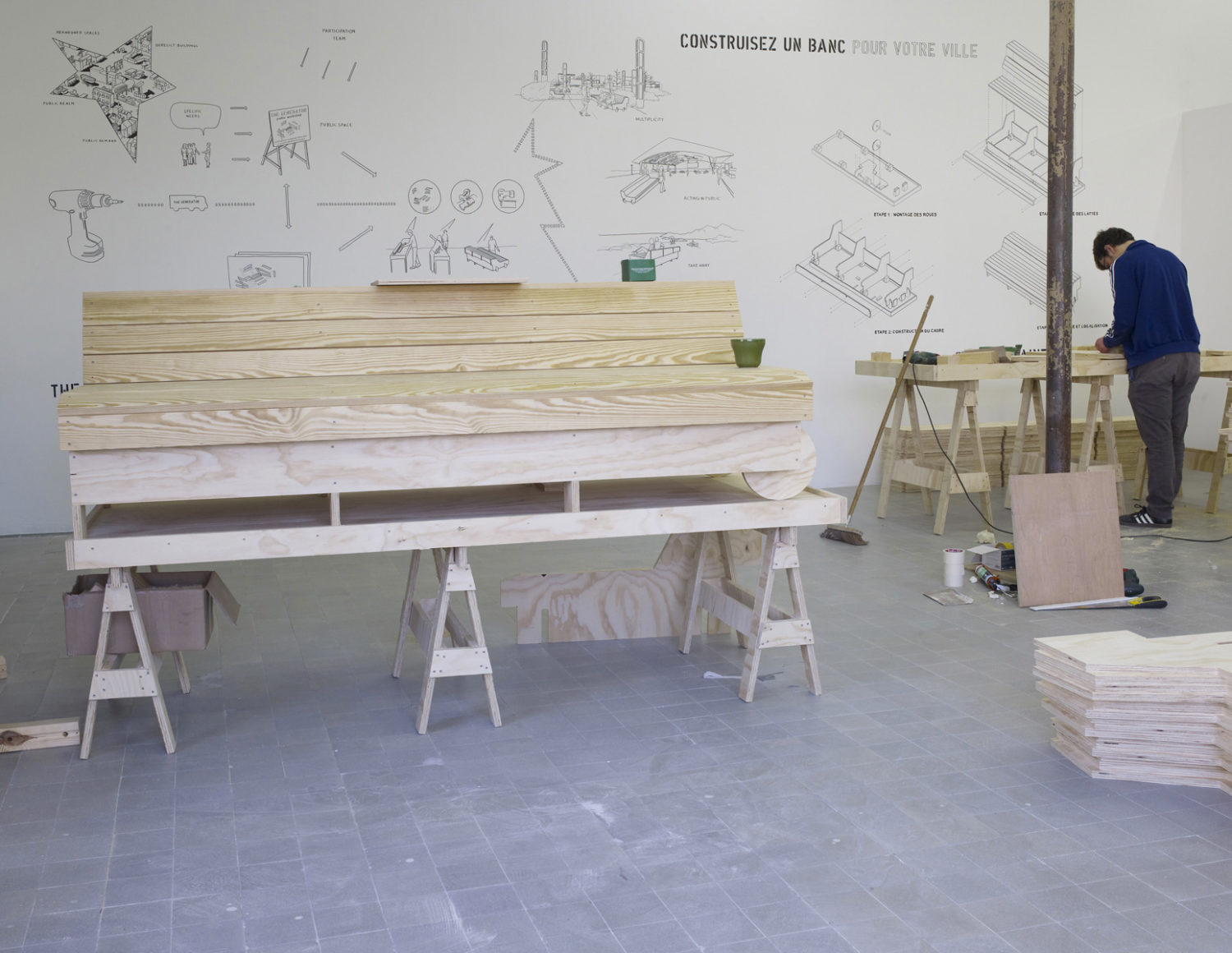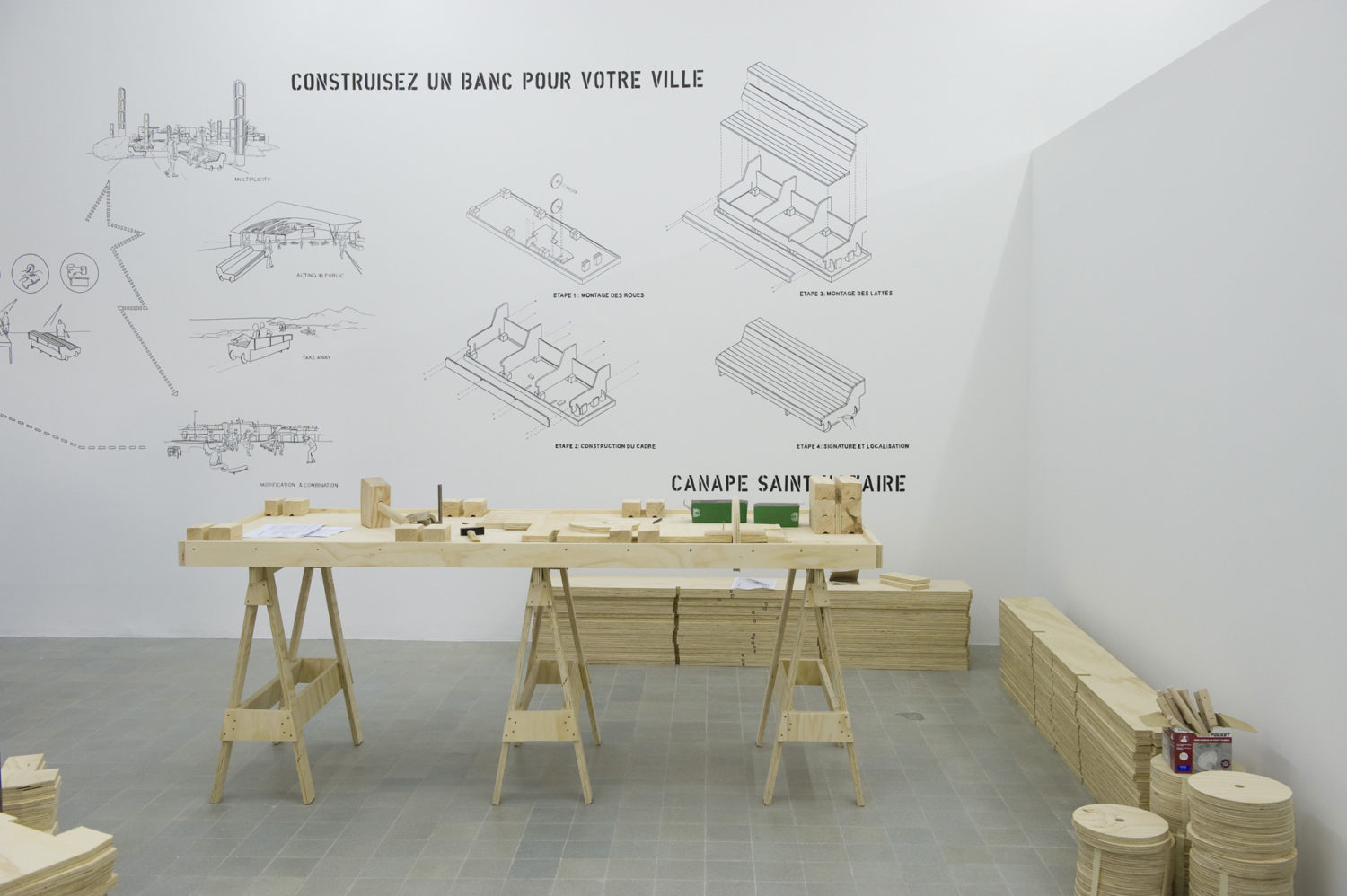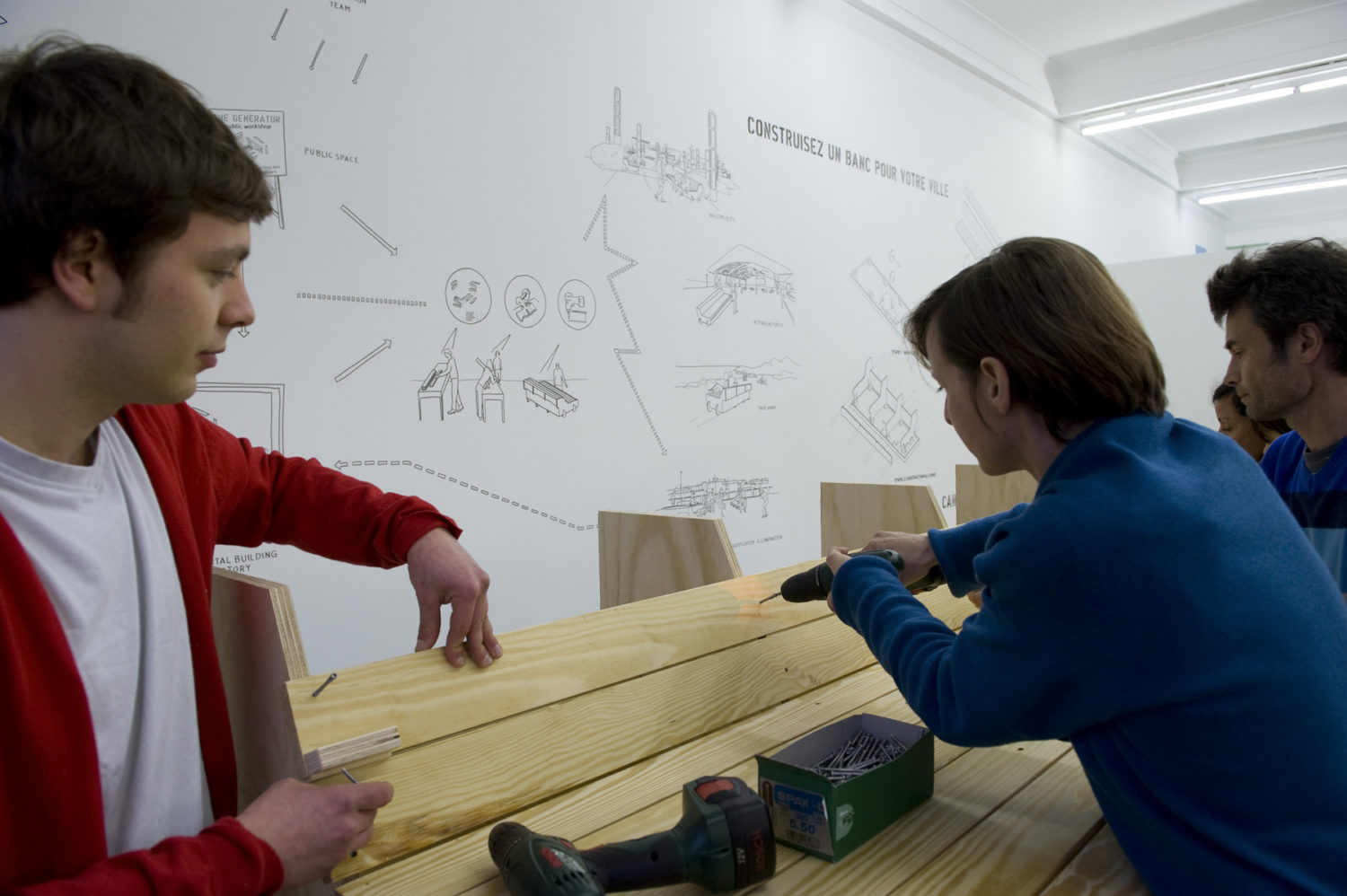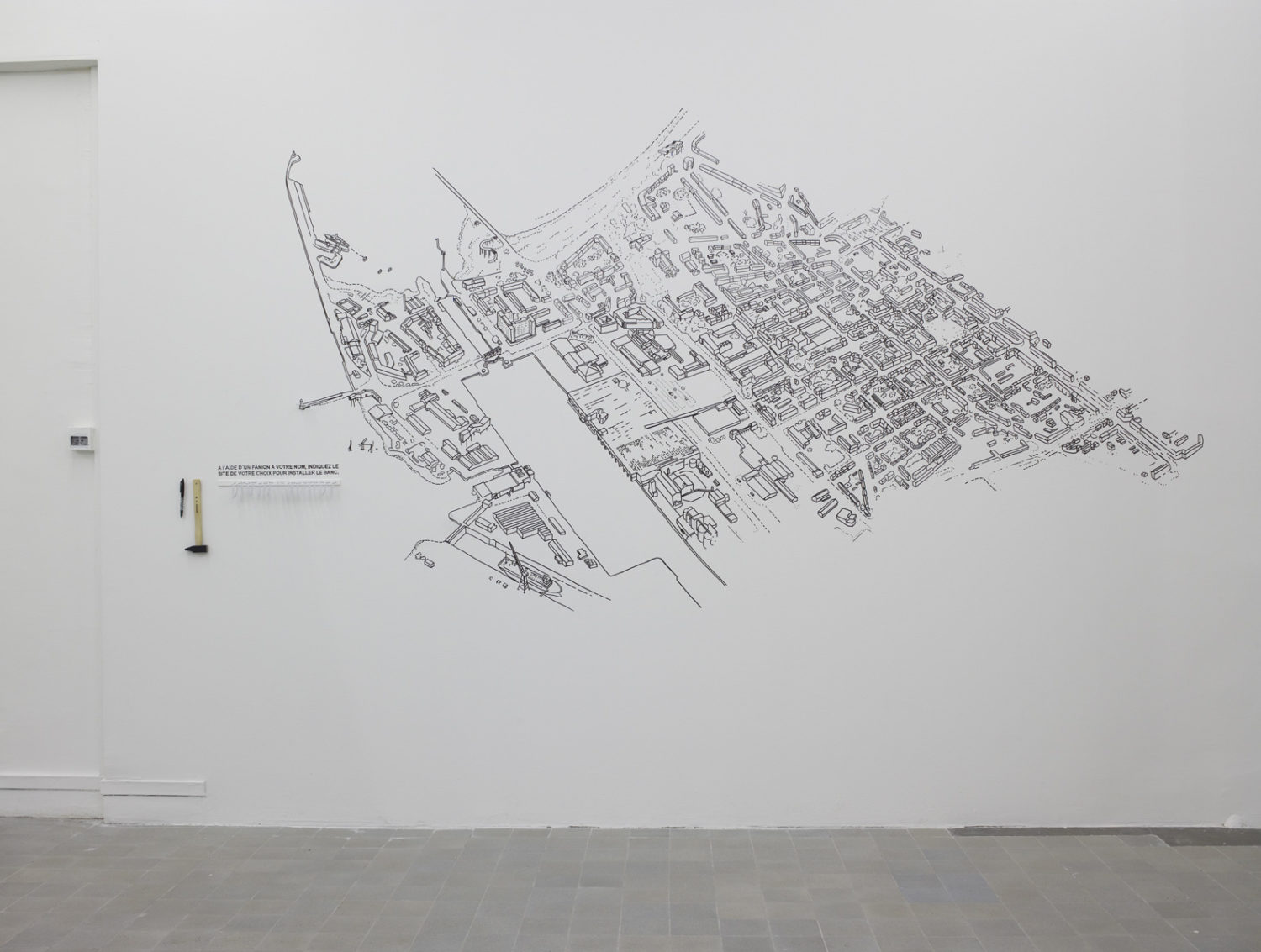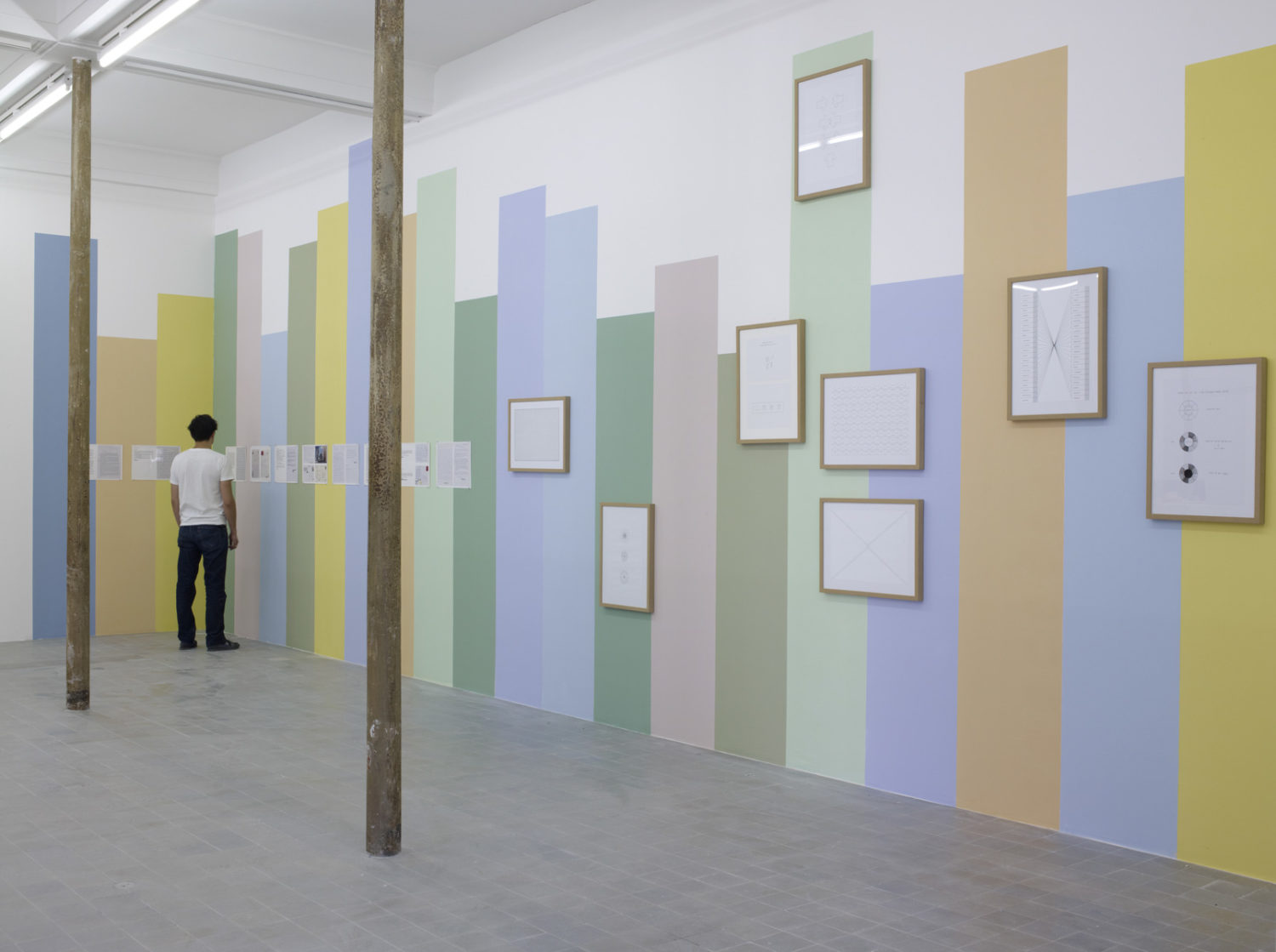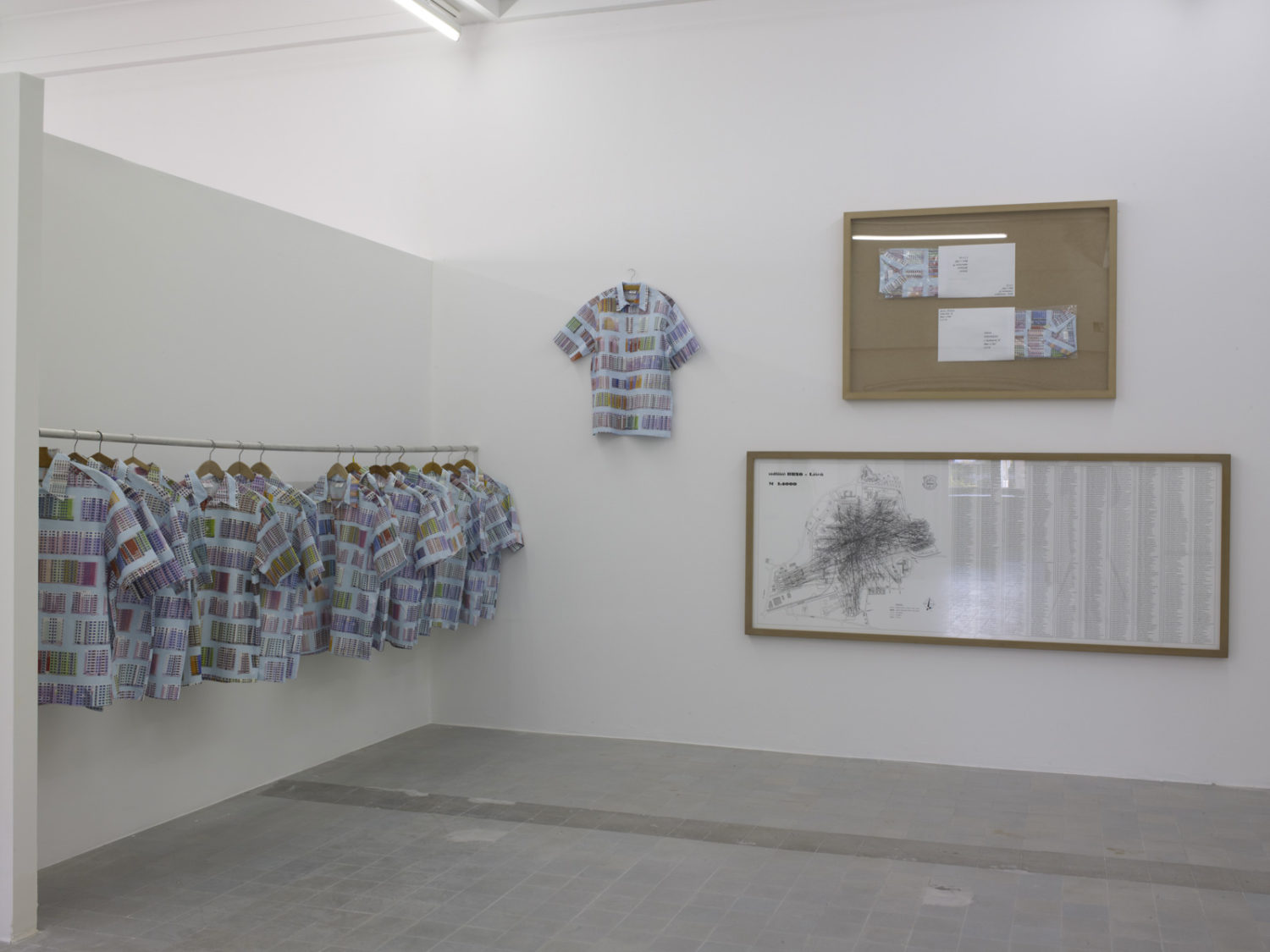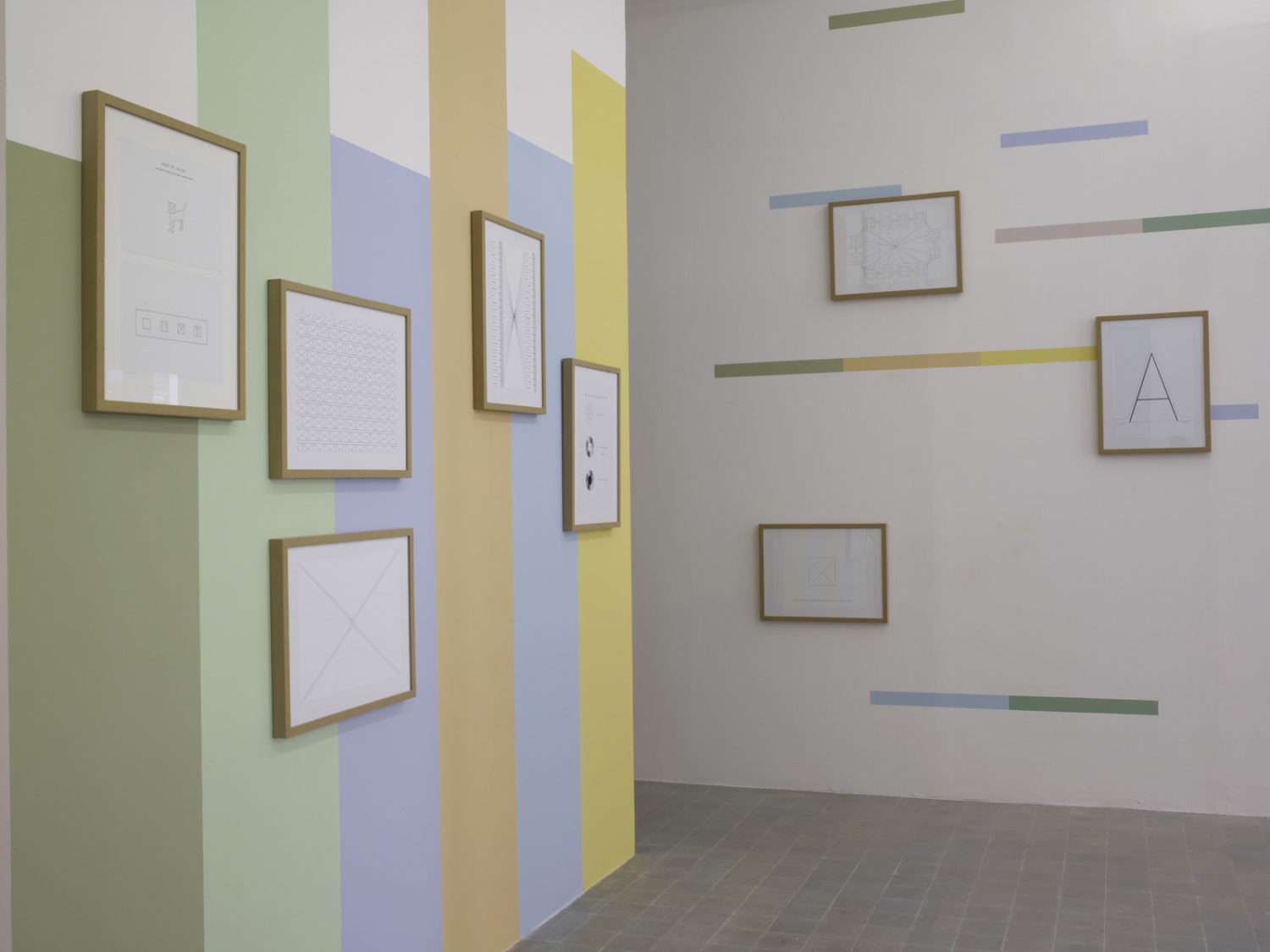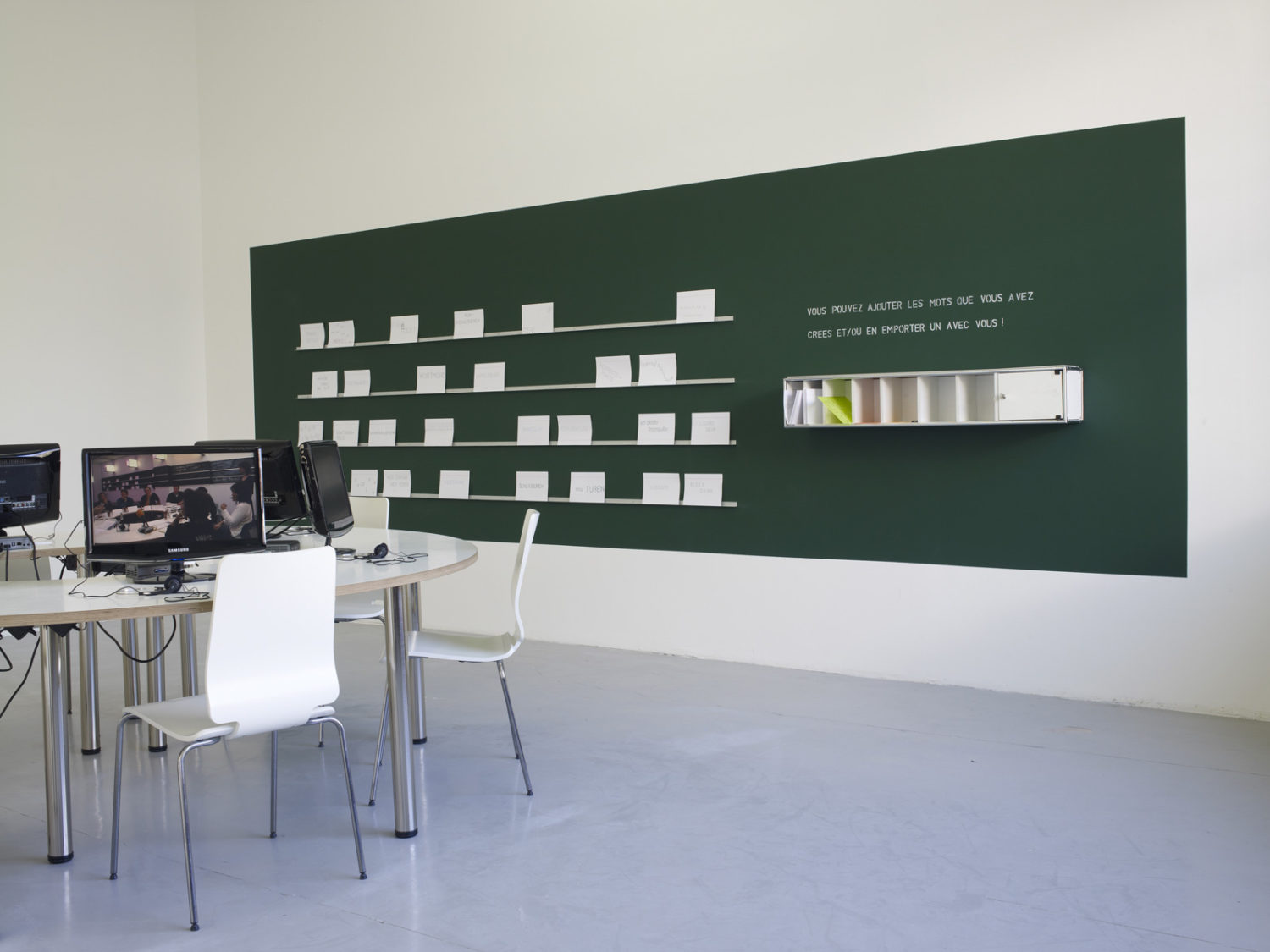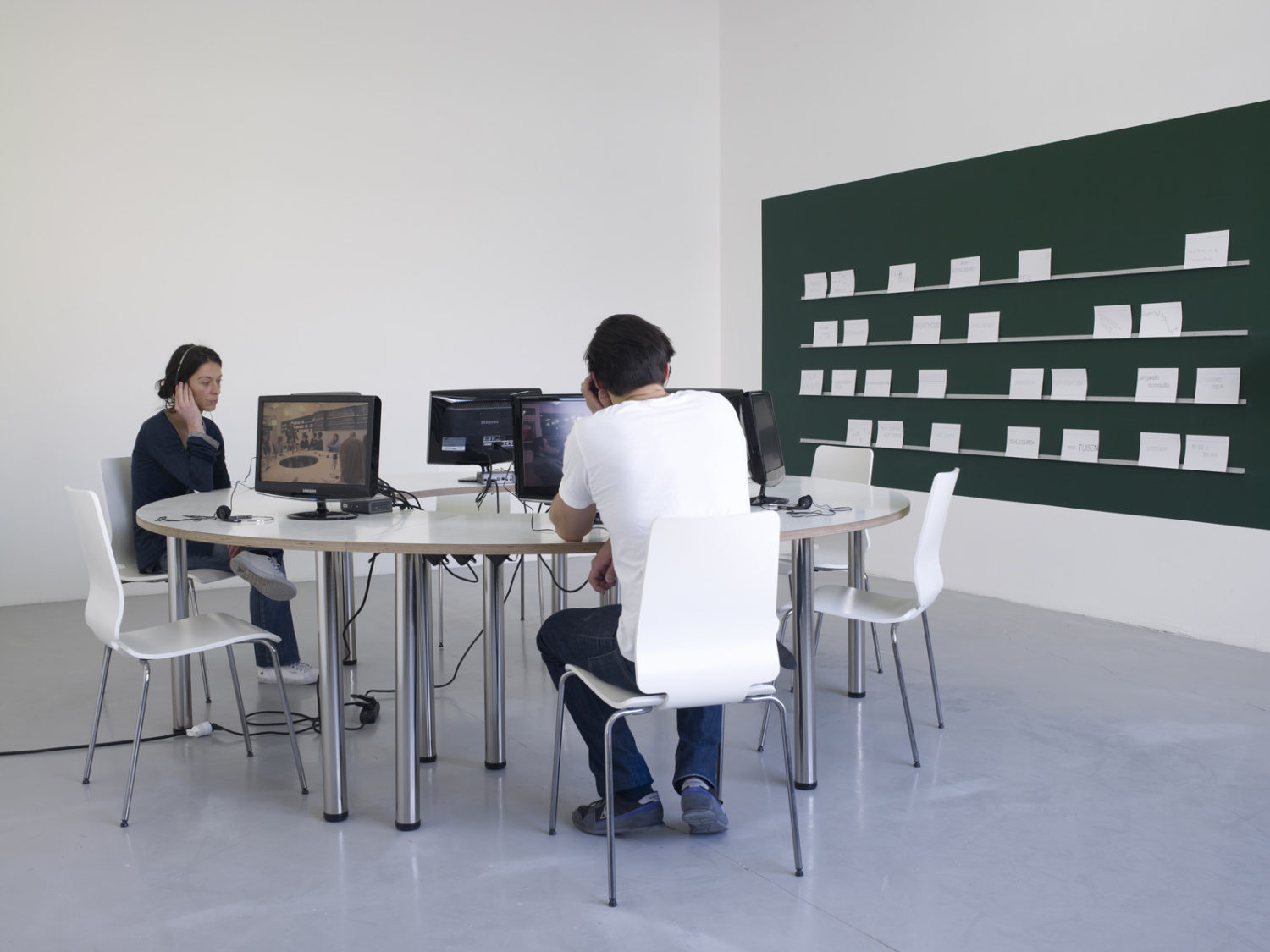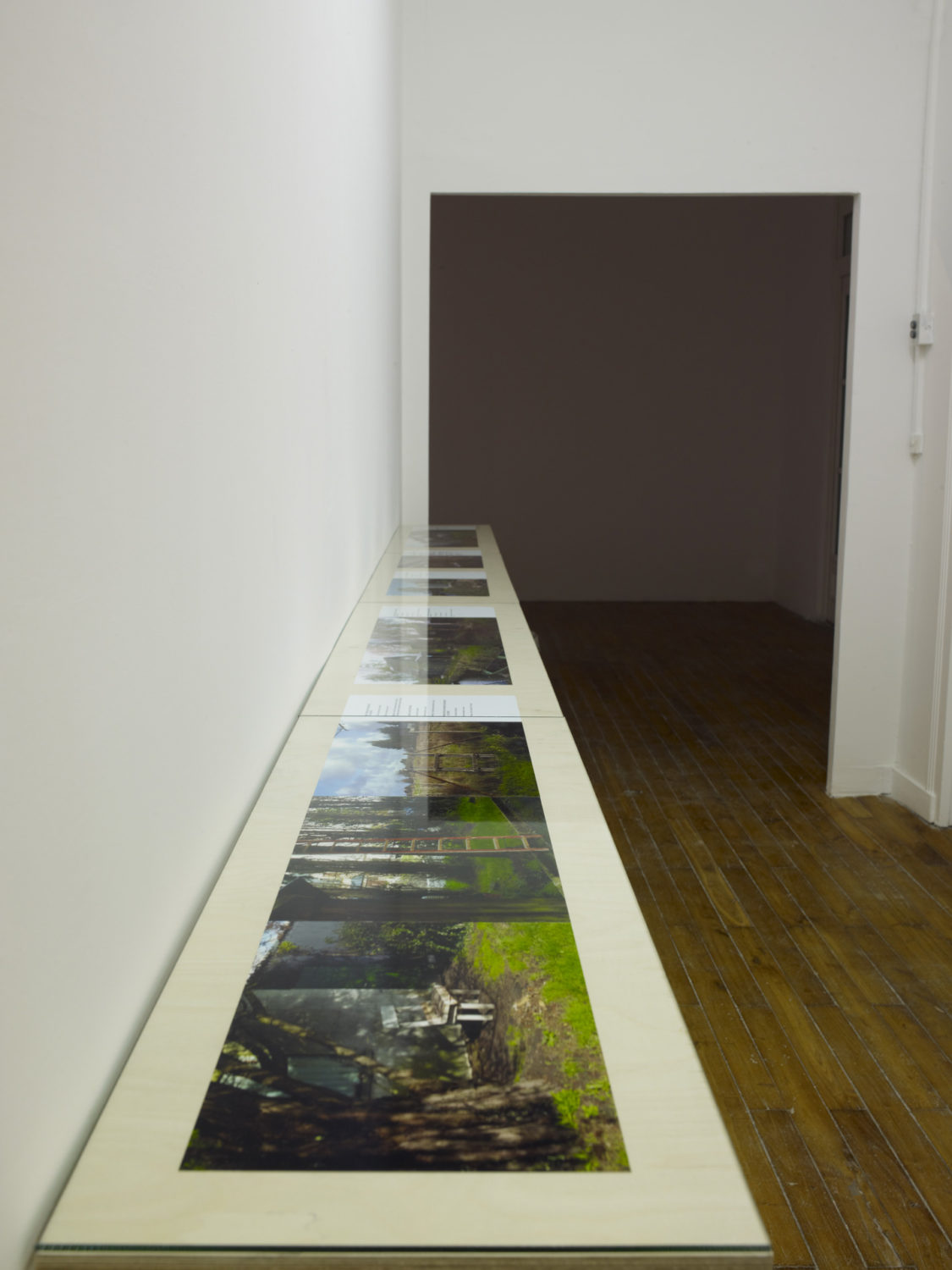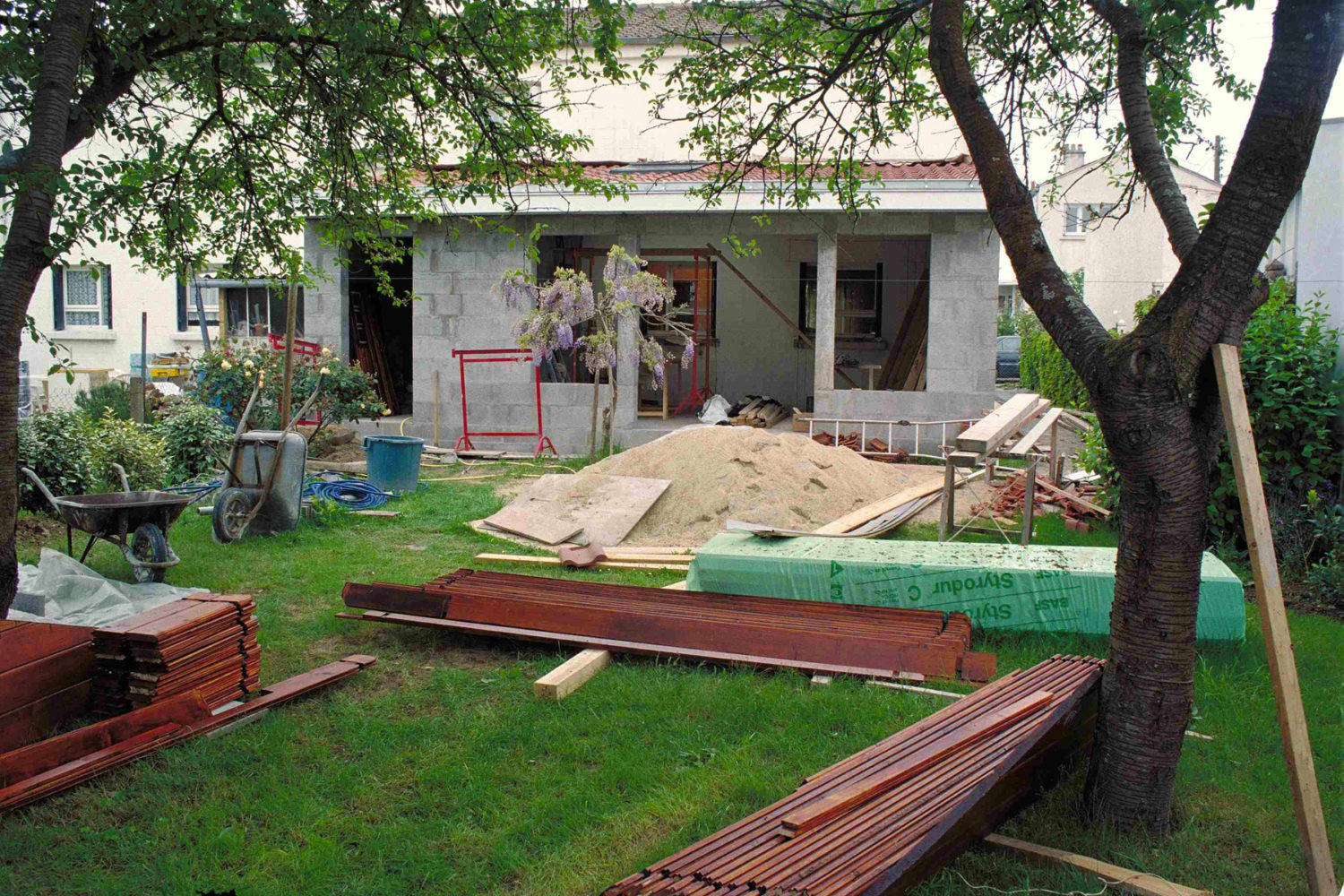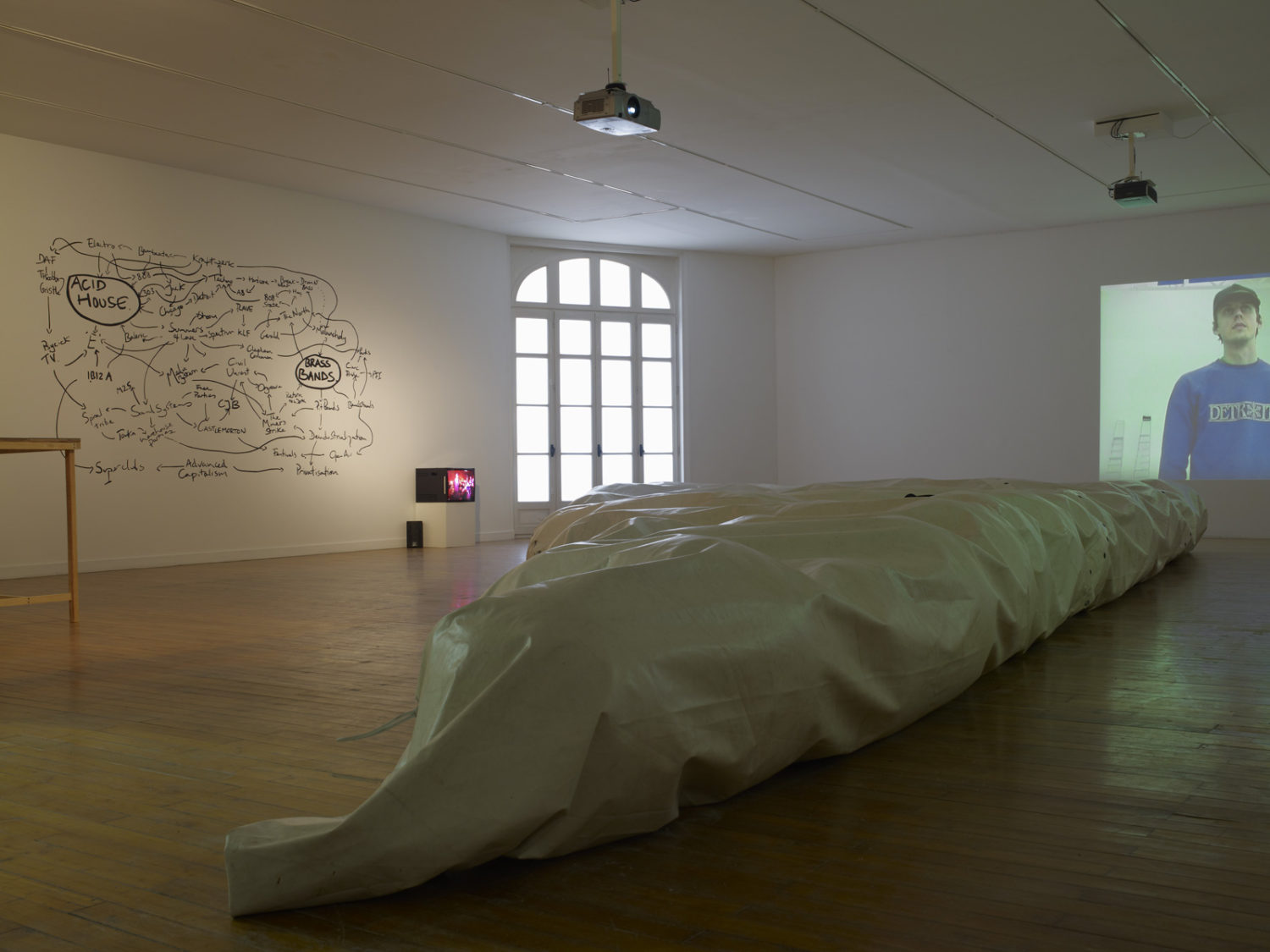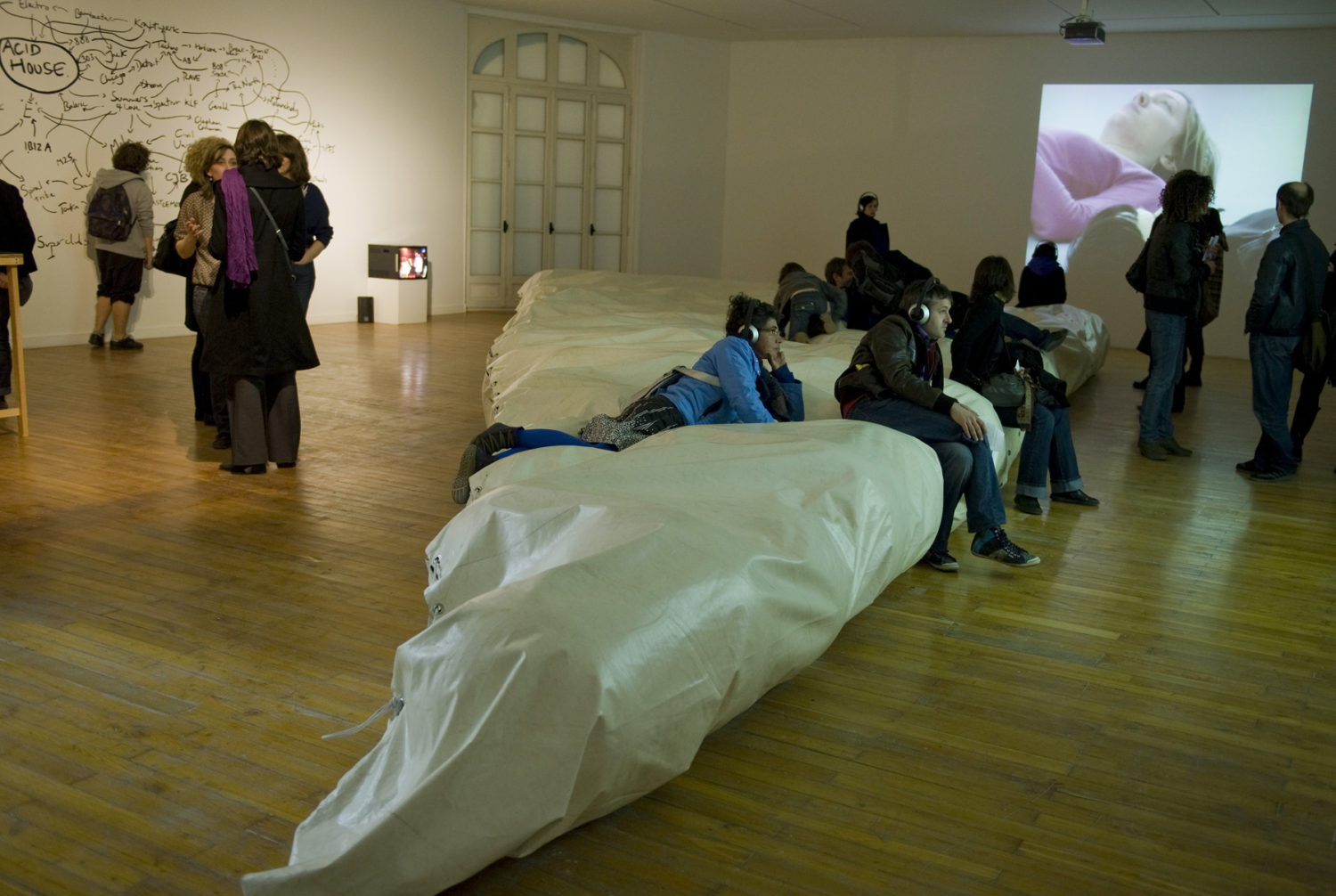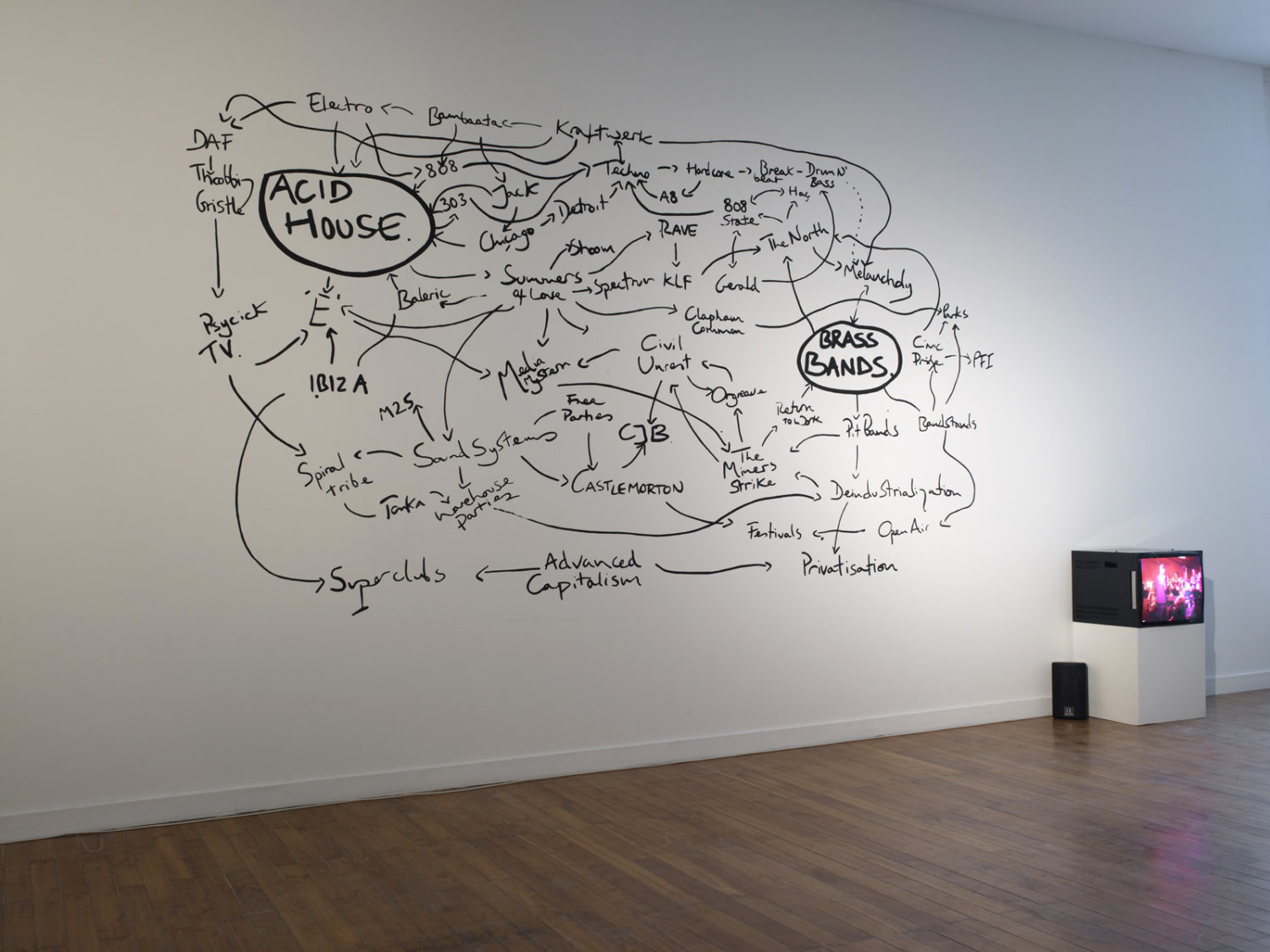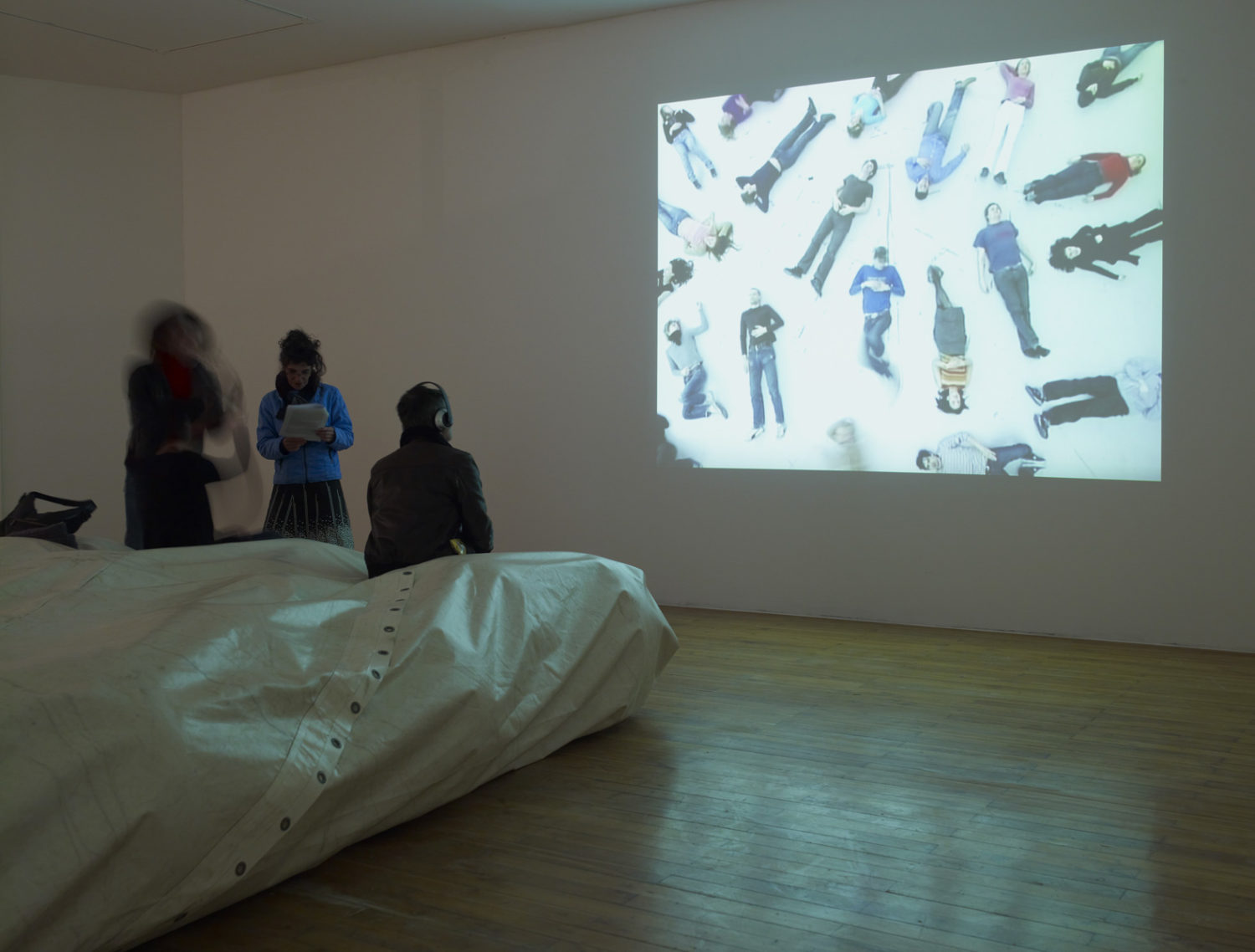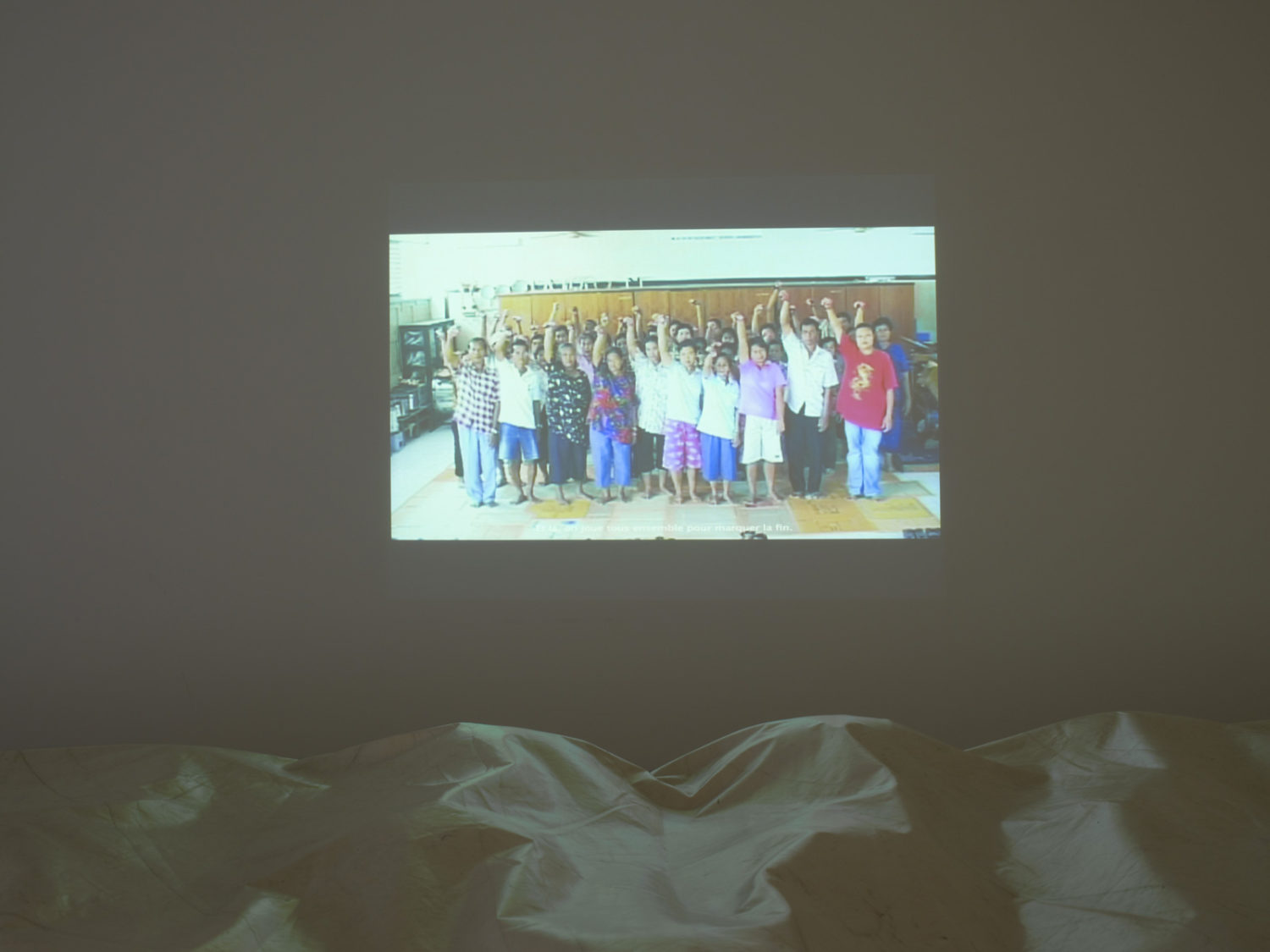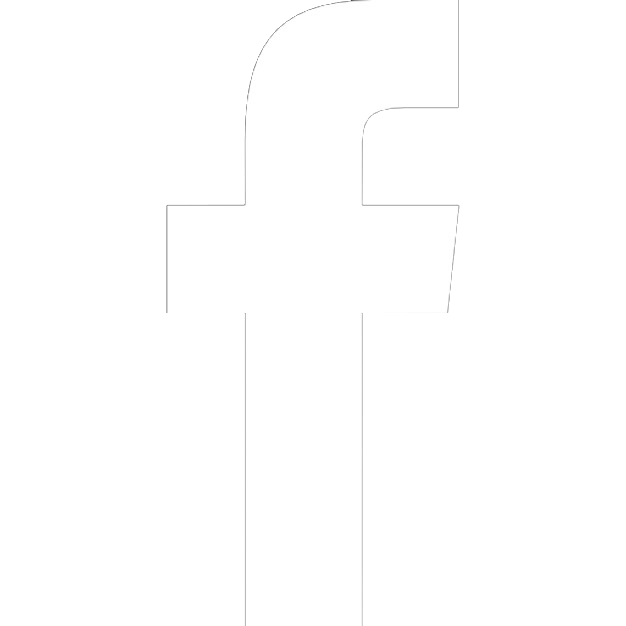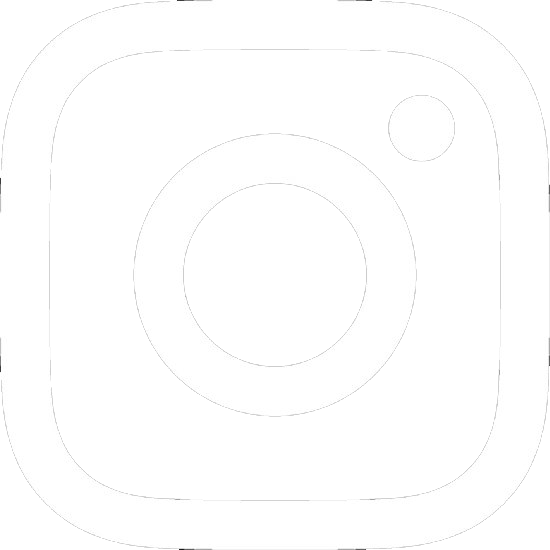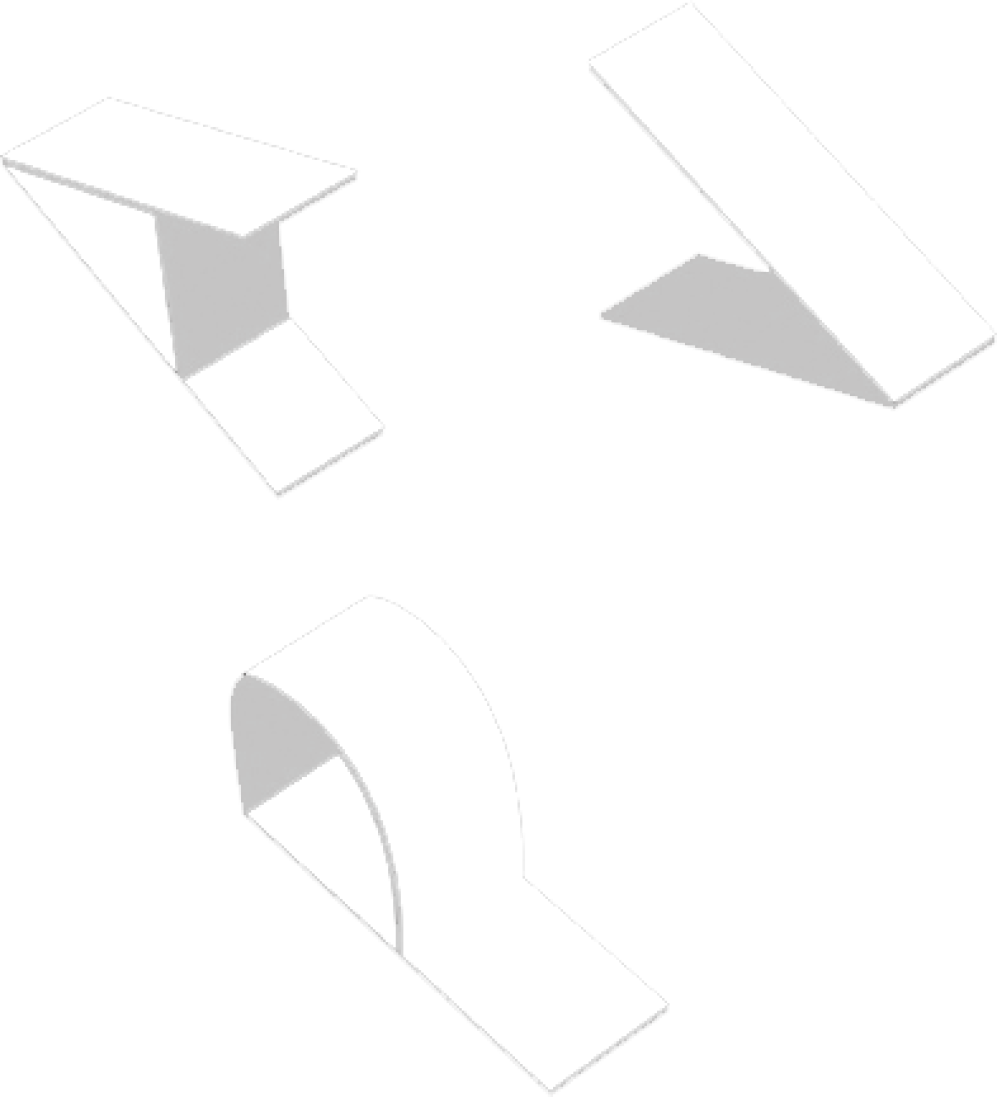Available documents
Exhibition
A community is by definition a social grouping united by ties that are either voluntary (intellectual affinities, a shared culture) or imposed (family, ethnic or national ties…). This question of “living together” (building, ritualizing, struggling together) always makes reference to an idea of poetic or political engagement. In recent years, the question has been posed a great deal on an international scale, notably as a response to the 2001 attack on the World Trade Center. How do we think of the world together?
The idea is experienced in daily life on a more local scale. Some of the utopias of 1968 have taken form today with a disconcerting pragmatism, in self-managed business communities, residents collectives, cooperative working groups. The community as opposed to the individual: this familiar idea can also take form in architectural projects, inventing spaces in which the experimental is welcome, spaces such as those formulated by the philosopher Joseph Vogl – where one can unlearn, “un-know” or initiate new relationships with one another. In parallel, virtual communities such as Facebook or Twitter have taken over the world. These social networks, which mix avowedly commercial ambitions with an undeniable relational philosophy, profoundly fabricate the concept of community as it is formulated by younger generations. They even facilitate the success of some revolutions…
The exhibition Communauté/Gemeinschaft bears witness to the way in which contemporary art takes hold of these realities and these interrogations. It brings together very diversely orientated researches, although each reflects the question of “being together”. The works call upon the fields of architecture, labour relations and politics, and likewise fashion, music and language: numerous domains grounding artistic positions that are always thought through in specific contexts.
Éva Prouteau
—
raumlaborberlin / Markus Bader, Jan Liesegang, Frauke Gerstenberg & Christian Göthner (Germany)
Certain works in the exhibition establish processes of communal construction: this is the case with City Mattress, a triangular inflatable sculpture conceived of by Markus Bader in collaboration with the architectural collective raumlaborberlin. This large white tarpaulin structure evokes the formal vocabulary of 1960s design and its modernist sources: originally conceived for the public space, here it is transferred to the interior of the Grand Cafe where it acts as a “sculpture of connections”. A site in which to recline, contemplate the other exhibited works, relax or play around. Visitors who experience the work thus become the actors of an open and fleeting assembly, at the crossroads of the private sphere and communal exchange.
For the exhibition Communauté/Gemeinschat raumlaborberlin & Jan Liesengand are also developing a specific project for Le Grand Café entitled Le Canapé de Saint-Nazaire [the Saint-Nazaire Sofa]. This consists in organising, at the heart of the show, a workshop fabricating wooden benches destined for the public spaces of Saint-Nazaire. Visitors are invited to spend about 20 minutes assembling planks of wood precut according to the schemas elaborated by raumlaborberlin. The design of the bench, or more exactly “sofa”, subverts the usual public benches on which one can neither sleep, nor lie down, nor choose for oneself the site one wants to occupy… A genuine invitation to recover a little intimacy and conviviality in the public space of Saint-Nazaire (which according to raumlaborberlin. is “like the world of Alice in Wonderland, immersed in exceptional relationships of scale), raumlaborberlin’s project invites all the actors, constructors, visitor-participants to meet up for a dinner on the sofa on Saturday May 14 in the south hall of the submarine base in Saint-Nazaire!
Jeremy Deller (Great Britain)
Artist Jeremy Deller also bears witness to the conditions of the emergence of a singular community whose protagonists are in principle hardly compatible: the members of a British workers’ brass band and fans of Acid House, an electronic dance music extremely popular in 90s England.
Deller brings together both these musical references in a large wall drawing revealing the troubling historical resonances between these working class brass bands, who have always supported the Labour party in the north of England, in particular during the Miners’ Strike movements of the early 1980s – and the rave parties that spread some years later through the disaffected warehouses of these same de-industrialised areas. The work History of the World 1997-2004 tells of these links, micro-phenomena that the artist transposes with humour to the scale of Great History.
His flowchart decodes how certain unemployed lovers of Acid House came to engage in the Labour party, and then how certain Acid House hits integrated the brass band repertoire. The accompanying video shows us the result of this musical fusion, christened Acid Brass: the artist films a performance of the famous Fairey Band, during which the greatest hits of Acid House are interpreted in the pure brass band tradition.
Johanna Billing (Sweden)
For several years artist Johanna Billing has been engaged with works that are close to stage direction: she “scenographies” communities, chiefly by means of video and group performances. Her study of collaborative practice and collective experience clear a path between fictional stagings and documentary, in which non-professional actors take part in situations entirely created by the artist. From manoeuvring a yacht to playing in an orchestra, Johanna Billing is often questioning the simple daily activities that reinforce community spirit.
The video Missing Out opens with a sequence showing the group: we see a group of people lying on the ground, with no clear order. Apparently nothing is happening: the image is polished, the framing very controlled, and we could imagine a photo shoot with a trendy photographer. In fact, Johanna Billing immersed herself in a childhood memory, a collective relaxation exercise that was common practice in Swedish nurseries and schools during the 1970s. “I realised that the reason I remember this precise moment so well is because the mistress had looked at me, and she had said “Everybody watch Johanna! She’s breathing well!” I understood – rather painfully – to what point this memory was linked to performance, to competition, and that something as simple as learning to breathe well when you are six years old can become a test where you come out of it better than your classmate lying down next to you.”
Going beyond the autobiographical anecdote, the video invites us to contemplate bodies at rest, facial expressions lost in thought. One person is the exception to the rule: she in fact ends up escaping from the scene, in her dreams at first and then for real, finally refusing to follow the others. A reflection on the social consensus, on conformism and competitiveness, Missing Out also draws on a state of reverie, in which Charles Baudelaire’s “Multitude-Solitude” is almost palpable.
Lara Almarcegui (Spain/Netherlands)
Lara Almargegui tracks the signs of the community in the urban and suburban fabric. An amateur of wasteland, building sites and vacant lots, she decodes towns by their absences, their irruptions and their faults.
On a 2003 residency in Saint-Nazaire, she became interested in self-build practices in a functional and rationalised town, visibly planned for collective living. In effect, within the population of port workers many had once recuperated diverse objects from their workplace – scrap, surplus or just ‘fallen from the back of a lorry’ – and reused them in their private space, often in their gardens. Entitled L’auto-construction à Saint-Nazaire [Self-building in Saint-Nazaire], her series of photographs retraces the processes of functional détournement and appropriation.
But above all the artist echoes the inventiveness at work in these spontaneous practices. Beyond the port activity that brings together the inhabitants, Lara Almarcegui reveals a more diffused community, which anchors the town’s identity in another way and reveals its singular vernacular.
Oda Projesi & Nadin Reschke (Turkey/Germany)
The basis of communication, language remains an indispensable prerequisite to all communal construction. What types of links are woven between a person’s mother tongue and that of their adopted country when the second is different?
In 2009, the artists’ collective Oda Projesi, based in Istanbul, implanted themselves in the Kreuzberg area of Berlin, where a large Turkish community lives. Particularly concerned by the phenomenon of linguistic circulation, Oda Projesi then began to study the hybrid language called “Kanaksprak”, a fusion of Turkish and German. Starting with this research carried out in collaboration with the Berlin artist Nadin Reschke, Oda Projesi imagined the project Tongue as an exploratory tool for this kind of linguistic innovation
As part of Tongue, a language course was offered to the public – three weeks’ training open to all, in which every participant can intervene as teacher or as student. The experience allowed the bases of a new language to be established, fed by everyone’s daily practice. In the exhibition Communauté/Gemeinschat the artists present the project in the form of an interactive installation that evokes school and language classes. Visitors are invited to take part in the dispositive by coining their own neologisms or noting their favourite expressions.
Bertille Bak (France)
Bertille Bak’s videos and installations question, with humanity and poetry, community energies of all kinds, with particular attention paid to the working class world. Whether filming the residents of a mining area in the north of France or inviting us to study an ant colony up close, the artist grasps the rituals that sustain the collectivity, in both a documentary and a dreamlike way.
In 2009 she went to Thailand, a country partly governed by the army that, since 2006, censors all expressions of resistance. In Bangkok she met the residents of Din Daeng, a, neighbourhood where housing is destined to be demolished for a shopping centre. In the video Safeguard emergency light system, the artist gives a voice to this struggling community, whose weapons are song, music, and the emergency pocket torches they use during the frequent power cuts. So she organises a small theatre of resistance by suggesting a morse code transcription of a popular song, whose message for the Thai people is implicitly one of resistance. And a ballet of fireflies appears at the windows of this block, whose demolition is imminent, a glitter of dissidence in a struggle that remains possible right up to the last minute, even with makeshift means, an ultimate gleam of hope in a disappearing world.
Kateřina Šedá (Czech Republic)
Kateřina Šedá approaches the notion of community playfully. Her friends, her family or the communities of residents that she meets serve as her pretext for inventing relational scenarios in which the artist plays with orchestrating reality to generate unexpected social interactions. Sensitive to the nature of the invisible ties regulating rituals within a group, Kateřina Šedá imagines some surprising game rules: in Nic tam není [There’s nothing here], she synchronises all the activities of the residents of the village of Morayian for one whole day. Following a meticulous schedule initiated by the artist, every inhabitant thus carries out exactly the same ordinary action (get up, do the housework, open the window, etc.) at the same moment in time. A video gives a form to this discreet choreography of barely modified reality, an intervention that lies ambiguously somewhere between disciplining and conviviality.
Human relationships are again at the heart of For every dog a different master, a project that came about in a housing estate on the outskirts of Brno, a soulless neighbourhood where the residents don’t know each other. Nevertheless, the area had just been rehabilitated, every tower had been repainted in bright colours. From photos of the repainted buildings, the artist had fabric printed, and had 1000 shirts made from this fabric. Instead of distributing these shirts among the residents by herself, she noted down the names of a thousand families living in the neighbourhood from their letterboxes and intercoms, and then grouped them into five hundred pairs, in such a way that, taking into account the respective positions of their blocks, the two families in a pair could not in principle know each other. On May 30 2007, she sent the thousand shirts by post to the thousand families, the other family of the pair appearing on the envelope as the sender.
Thus the Vedrova family, at Kotlanova 8, received a shirt sent by the Kosova family at Kosikova 4, and the Kosovas received a shirt sent by the Vedrovas. All of this protocol was carefully documented, filed and archived. Kateřina Šedá then waited for a month: many of the families had contacted each other, people had worn the shirts, strangers had met and spoken to each other. After a month, the thousand families were invited to the Morave gallery in Brno for the “Private View” of the project, and the artist then met this new community that she had subtly contributed towards creating.
—
The exhibition Communauté/Gemeinschaft is part of the project thermostat, cooperations between 24 French and German art centers.
Founded by German Federal Cultural Foundation, le Ministère des Affaires Étrangères et Européennes et Der Bevollmächtigte der Bundesrepublik Deutschland fur kulturelle Angelegenheiten im Rahmen des Vertrages uber die deutsch-französische Zusammenarbeit.
Production
Artworks
Variable dimensions
Courtesy Franco Soffiantino Gallery, Turin
Installation, 6 HD video, paper, mixed media
Courtesy Oda Projesi and Nadin Reschke
Variable dimensions
Courtesy of the artiste
Wallpainting, video
Variable dimensions
Courtesy Art Concept Gallery, Paris
7 min
Courtesy of the artist and Xippas Gallery, Paris
3 min 14 s
Courtesy of the artist and Hollybushs Gardens Gallery, London
Biographies
Raumlaborberlin
Markus Bader, Frauke Gerstenberg, Jan Liesegang & Christian Göthner (Germany)
Lara Almarcegui
Born in Saragosse, Spain, in 1972.
Lives and works in Amsterdam, Netherlands.
Nadin Reschke
Born in Bernburg an der Saale, Germany, in 1975.
Lives and works in Berlin, Germany.
Bertille Bak
Born in 1983 in Arras (France).
Lives and works in Paris and le Nord Pas-de-Calais, France.
The artist is represented by the Galerie Xippas (Paris).
Kateřina Šedá
Born in Brno, Czech Republic, in 1977.
Lives and works in Brno and Prague, Czech Republic.
